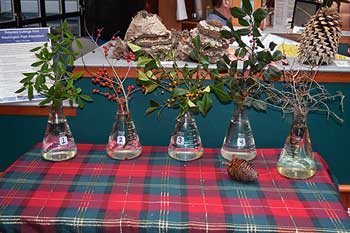Deck the Halls
Boughs used as winter decoration are often from plants in the genus Ilex. Many Ilex, or holly species are dioecious, meaning that male and female reproductive organs are separated on individual plants. This trait promotes cross-fertilization which increases genetic variability, but can decrease seed-setting efficiency. Solitary individuals are unable to be pollinated, therefore it is necessary that male and female plants grow in close proximity or female plants will not produce berries.

1) Ilex cassine var. mexicana
- This large, fast-growing evergreen is native to the southeastern coast of the U.S. as well as Mexico, Puerto Rico and Cuba.
- A healthy specimen can be found in grid 13-3W, just west of Lake Washington Boulevard.
2) Ilex verticillata ‘Red Sprite’
- This female, deciduous Ilex cultivar reveals large red berries when its leaves fall.
- Our best patch can be found along the path in the Joe Witt Winter Garden planted next to the male pollinizer, Ilex verticillata ‘Jim Dandy’.
3) Ilex opaca ‘Boyce Thompson Xanthocarpa’
- Evergreen tree that grows rapidly and assumes an attractive conical shape. As with most of the American Holly clade, this tree is cold hardy but not very wind-tolerant.
- Berries can be crimson-red, yellow or orange.
4) Ilex opaca ‘Emily’
- Found in the Pacific Connections Meadow plantings, this evergreen female boasts copious quantities of vivid red fruits, starting at a very young age.
5) Ilex serrata
- Located in the deciduous Holly clade on the west side of Lake Washington Boulevard, this holly spreads and suckers to form colonies.
- Small red berries are revealed in late autumn after the leaves have fallen.